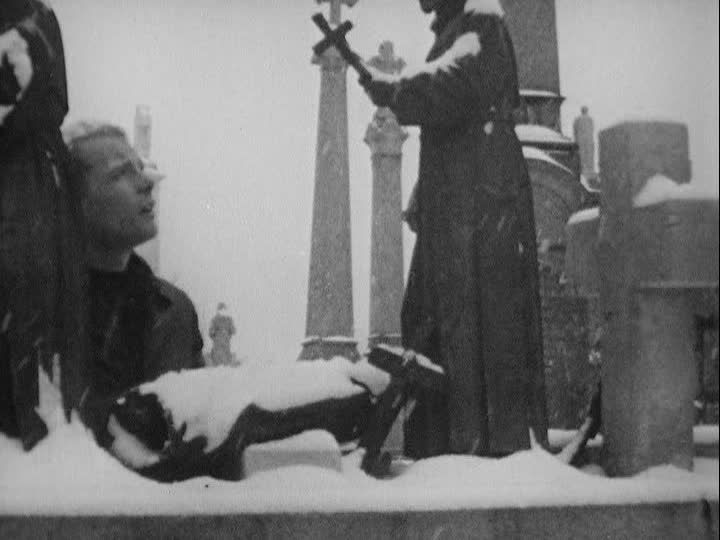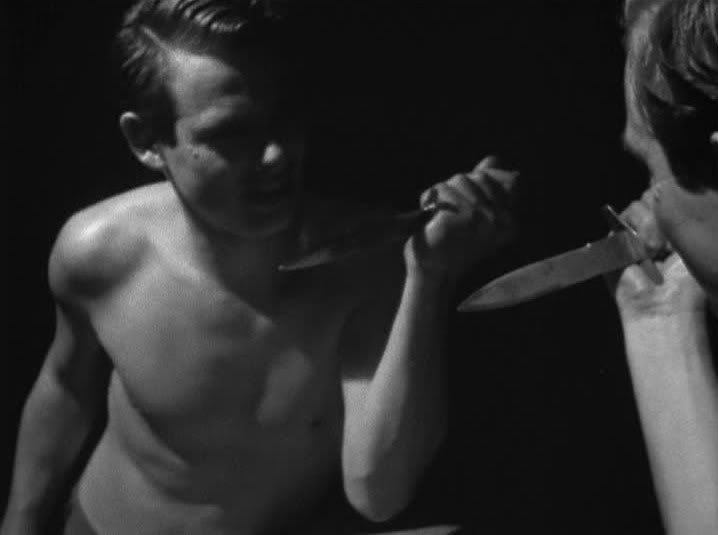
Image in the Snow is Willard Maas' moody, densely symbolic examination of a young man's journey through an increasingly grim and dilapidated cityscape, culminating in a despairing collapse at a snowy cemetery, amidst the foreboding stone statues of crosses and angels. The young hero (Hunter Jones) is an aimless drifter who might stand in for Maas himself in what seems to be a very personal film. The hero is besieged by various visions of homoerotic sexuality, as well as women who represent mythical princesses or mothers, embodiments of eternal, symbolic femininity as a contrast against the lushly sensual depictions of the male body. As the hero wanders around a rooftop, a male bodybuilder appears beside him, flexing his muscles and posing; while the hero remains in focus, the half-naked man is out-of-focus until Maas cuts in for a closeup that starts at the man's crotch, admiring the bulge in his underwear before panning up his torso. Soon after, a male dancer twists and pirouettes across the rooftop, his body gracefully contorting in dreamlike slow motion.
These images, so provocative and overtly sensual, are juxtaposed against a much more matronly depiction of womanhood. Notably, Maas' own wife, the remarkable filmmaker Marie Menken, appears as the hero's mother — a casting decision fraught with Freudian psychological implications, that — and the hero also has a brief encounter with a "princess" (Ellen McCool) which is simultaneously sexual and violent, a scene that's broken off almost as soon as it begins.
The film opens with a few minutes of narration over a black screen, and this portentous, purplish poetry continues throughout, full of overblown imagery and heavyhanded symbolism, intoned with a homilistic lilt by Ben Moore. The narration's best moment comes towards the end of the film, when Moore begins singing, in a sweet, wavering voice, some childhood religious hymns, lullabies that resonate against the image of the hero in a cemetery, peering into a locked crypt filled with Christian icons. This eerie, suggestive juxtaposition validates the film's voiceover, even though much of the rest of the poetry that accompanies the film is bland and extraneous in comparison to the low-budget beauty of the imagery.
Indeed, the film would probably work better silent, or accompanied only by Ben Weber's effectively dramatic string score. Maas' imagery has a gritty elegance that suggests a number of symbols and associations without being as literal as the narration sometimes is. The film provides a tour of an urban environment from the point of view of a young man overwhelmed by sensual stimulation and confused by his own alternately desperate and melancholy emotions. As he wanders, the city increasingly becomes desolate, its buildings ruined, and he climbs over piles of concrete debris and junk, walking down unpopulated streets, surrounded on all sides by tall, blank buildings that betray no evidence of their purpose or their occupants. Best of all is the film's haunting climax, with the snow wafting constantly across the frame, the hero buffeted by gusts of wind that blow cloud puffs across his path, the stone relics of the graveyard rising up around him on all sides, often filmed from below to lend them even more imposing grandeur. This gorgeous imagery proves that the film doesn't truly needs its overly wordy narration, which is only rarely as effective as the wordless suggestiveness of Maas' cinematography.

The Plague Summer is Chester Kessler's adaptation of the poet Kenneth Patchen's avant-garde novel The Journal of Albion Moonlight, a surreal and unsettling parable of war and social breakdown. Kessler's adaptation sets deadpan narration of excerpts from the novel against a series of crude pencil drawings, mostly static with no attempt at animation. The narration in itself is compelling, and Patchen's surreal stream of disconnected scenes and descriptions presents an eerie, absurdist vision of war's destabilizing effect. The narrator's bland, affectless voice recounts members of a small group of people disappearing in the night, raped and beheaded or stabbed and drowned, while wild dogs follow them everywhere. An account of a battle describes how the two opposing sides halt every so often so that the men can switch uniforms with the opposing army before the fighting resumes, now with the interchangeable foot soldiers swapped around.
It's obvious that Patchen has some interesting ideas and a bleakly compelling style, but Kessler's minimalist illustrations do little for the story. The childlike drawings are mostly static, and only very rarely does Kessler try to animate multiple drawings in sequence. Mostly, he just illustrates Patchen's words with a rather disappointingly literal-minded sensibility, so that the images and the words are redundant with one another — and Patchen's prose is certainly the more stylish and enduring presentation of these ideas. The best and most cinematic moment comes when the narrator describes the films of a land he's passing through, where all their movies consist only of photographers pointing cameras at other photographers with cameras in a never-ending recursive loop. Kessler illustrates this with a choppy montage of cameras in different locations within the frame, suggesting the meta content of these imagined movies.
For the most part, though, Kessler's drawings don't reveal that much imagination in interpreting Patchen's prose. One spot where, presumably, he does show some imagination is in depicting the character of "the murderer" as a burly, bare-chested black man in a top hat, carrying a gun, an illustration which, if it isn't derived from Patchen's original, is a bit of racist stereotyping that severely undermines the film's supposedly leftist political message. But even aside from such missteps, The Plague Summer is a mostly uninteresting slog that does very little compelling with Patchen's ideas and writing.

John E. Schmitz was a little-known filmmaker associated with Kenneth Anger, and his film The Voices is best known for being seized by authorities as part of the same raid that targeted Anger's seminal Fireworks. The Voices is a noirish psychodrama in which a young man struggles with his sexuality in a dream state. The short concerns a fitfully sleeping youth who has an eerie dream of wandering like a ghost through a world of shadow and darkness, an abstracted void in which everything around him is utterly swallowed up by the black. He walks through the darkness with hand outstretched, holding a cross, then comes upon a reflection or doppelganger of himself and admires his own handsome, square-jawed face and muscular body — and then, he reaches offscreen and grabs a knife, caressing it as well, as though its sharp blade is an extension of his body, another fine form to admire. (It replaces the cross as his object of protection, substituting violence for religion or maybe suggesting that they're one and the same, that to worship one is to worship the other.)
Soon he's wandering an urban space that's initially brighter, more well-defined and naturalistically shot, but then once again gets reduced to a minimalist wasteland of crisscrossing shadows, where the young man arrives at a window, a solitary source of pale light in the darkness, and voyeuristically peers in at a woman undressing for bed. When she gets naked, he clutches at his heart, as though in pain, and afterwards he flees the darkness into a washed-out bright white light, holding his cross aloft once again as he marches to drown in a lake.
Though it's never explicit as such, it's obvious that, like Maas' Image in the Snow, this film is dealing with repressed homosexual feelings, or at least uncertainty about sexual identity: the man is attracted in turn to his own mirrored form and a naked woman. Schmitz's elliptical, dreamlike imagery suggests multiple symbolic interpretations, as this confused young man grapples with religion, guilt, desire, voyeurism and angry violent impulses, all of it swathed in the deep black shadows of a noir thriller. This is a thriller that takes place entirely in the mind, though, and even if its imagery sometimes verges on the clichéd, it's an interesting and hauntingly shot film.

5 comments:
"dreamlike imagery suggests multiple symbolic interpretations, as this confused young man grapples with religion, guilt, desire, voyeurism and angry violent impulses,"
IOW Teh Ghey
Such scenarios were common in gay avant-garde films of the period. Pauline Kael made mocking mention of them in her essya "The Glamour of Delinquency" (in I Lost It at the Movies) speaking of James Dean, kael writes --
"With East of Eden Hollywood has cuaght up with the main line of American avant-garde cinema -- those embarrassingly autoerotic twelve-minute masterpieces in which rejected, inexplicable, and ambiguous figures are protographed in tortured chiaroscuro, films which exude symbolism as if modern man were goign to find himselfby chasing the shadow of an alter ego in a dark alley. When alienation is exploited for erotic gratification, film catches up with the cult realities of city parks and Turkish baths; clear meanings or definite values would be too grossly explicit -- a vulgar intrusion on the Techniclor night of the soul."
IOW she never got over her inability to get James Borughton to "change teams" (as Seinfeld would say.)
Yeah, both The Voices and Image in the Snow are obviously about gayness, about grappling with sexuality and youth. I've read that Kael piece before, it's a good example of her missing the point, certainly on the subject of the avant-garde.
Always a treat to read your pieces on experimental cinema, Ed. I haven't seen any of these (Voices seems familiar but I think I'm confusing it with another film; not hard to do as Kael suggests tartly in her piece -interesting though she doesn't mention the obvious influence of Hean Cocteau, whom she admired if I'm not mistaken, on this type of cinema).
Images in the Snow sounds great and the fusion of natural imagery and eerily empty urban landscapes remind me of several dreams I've had. Your thoughts on voiceover are interesting too; I've been working in a story recently that leans heavily toward narration and dialogue and it's important to remind myself that, despite notable exceptions like My Dinner with Andre and the Six Moral Tales, the default storytelling style for cinema should probably be 'images speak louder than words...'. Sorry to hear that second film's a letdown though as I quite liked the picture you chose to illustrate it.
*Jean Cocteau obviously.
Thanks, Joel. I think these kinds of films are so interesting precisely because they can tap into dreams in this way - probably most people have had dreams that feel like The Voices or Image in the Snow in one way or the other.
And yes, it can be tough to incorporate literary elements into films that communicate so powerfully in visual terms. This is certainly not the first avant-garde film I've come across that plays better on mute.
Post a Comment